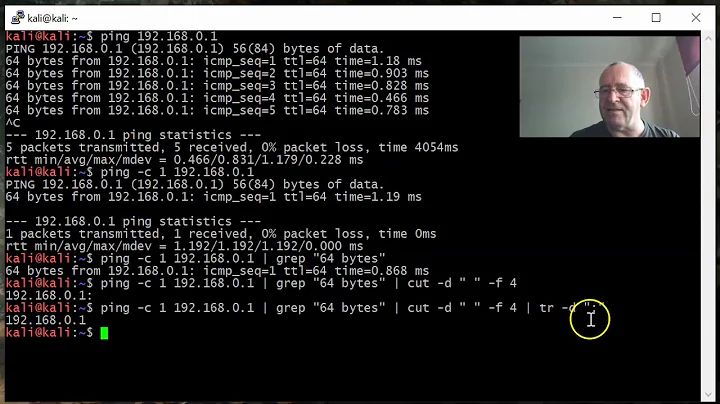How to display IP address of eth0 interface using a shell script?
Solution 1
For the sake of providing another option, you could use the ip addr command this way to get the IP address:
ip addr show eth0 | grep "inet\b" | awk '{print $2}' | cut -d/ -f1
-
ip addr show eth0shows information abouteth0 -
grep "inet\b"only shows the line that has the IPv4 address (if you wanted the IPv6 address, change it to"inet6\b") -
awk '{print $2}'prints on the second field, which has the ipaddress/mask, example172.20.20.15/25 -
cut -d/ -f1only takes the IP address portion.
In a script:
#!/bin/bash
theIPaddress=$(ip addr show eth0 | grep "inet\b" | awk '{print $2}' | cut -d/ -f1)
Solution 2
Note: This answer is for older systems. If this does not work for you please consider other answers. This answer is not incorrect.
save this in a file and then run bash <filename>
#!/bin/bash
ifconfig eth0 | grep "inet addr"
being more accurate to get only number showing IP address:
#!/bin/bash
ifconfig eth0 | grep "inet addr" | cut -d ':' -f 2 | cut -d ' ' -f 1
Update: If this doesn't works for you, try the other answer
Update: For Ubuntu 18+, try: (don't forget to replace eth0 with interface you need the IP for. Thanks to @ignacio )
ifconfig eth0 | grep "inet " | awk '{print $2}'
Solution 3
Taken from https://stackoverflow.com/a/14910952/1695680
hostname -i
However that may return a local ip address (127.0.0.1), so you may have to use, and filter:
hostname -I
From hostname's manpages:
-i, --ip-addressDisplay the network address(es) of the host name. Note that this works only if the host name can be resolved. Avoid using this option; use hostname --all-ip-addresses instead.
-I, --all-ip-addressesDisplay all network addresses of the host. This option enumerates all configured addresses on all network inter‐faces. The loopback interface and IPv6 link-local addresses are omitted. Contrary to option -i, this option does not depend on name resolution. Do not make any assumptions about the order of the output.
Solution 4
@markus-lindberg 's response is my favourite. If you add -o -4 to ip's flags then you get a much more easily parsable (and consistent) output:
ip -o -4 a | awk '$2 == "eth0" { gsub(/\/.*/, "", $4); print $4 }'
-o stands for --oneline, which is meant to help in exactly this kind of situations. The -4 is added to limit to the IPv4 address, which is what all the other responses imply.
Solution 5
You should use ip (instead of ifconfig) as it's current, maintained, and perhaps most importantly for scripting purposes, it produces a consistent & parsable output. Following are a few similar approaches:
If you want the IPv4 address for your Ethernet interface eth0:
$ ip -4 -o addr show eth0 | awk '{print $4}'
192.168.1.166/24
As a script:
$ INTFC=eth0
$ MYIPV4=$(ip -4 -o addr show $INTFC | awk '{print $4}')
$ echo $MYIPV4
192.168.1.166/24
The output produced above is in CIDR notation. If CIDR notation isn't wanted, it can be stripped:
$ ip -4 -o addr show eth0 | awk '{print $4}' | cut -d "/" -f 1
192.168.1.166
Another option that IMHO is "most elegant" gets the IPv4 address for whatever interface is used to connect to the specified remote host (8.8.8.8 in this case). Courtesy of @gatoatigrado in this answer:
$ ip route get 8.8.8.8 | awk '{ print $NF; exit }'
192.168.1.166
As a script:
$ RHOST=8.8.8.8
$ MYIP=$(ip route get $RHOST | awk '{ print $NF; exit }')
$ echo $MYIP
192.168.1.166
This works perfectly well on a host with a single interface, but more advantageously will also work on hosts with multiple interfaces and/or route specifications.
While ip would be my preferred approach, it's certainly not the only way to skin this cat. Here's another approach that uses hostname if you prefer something easier/more concise:
$ hostname --all-ip-addresses | awk '{print $1}'
Or, if you want the IPv6 address:
$ hostname --all-ip-addresses | awk '{print $2}'
As a script:
$ MYV4IP=$(hostname --all-ip-addresses | awk '{print $1}')
$ MYV6IP=$(hostname --all-ip-addresses | awk '{print $2}')
$ echo $MYV4IP
192.168.1.166
$ echo $MYV6IP
2601:7c1:103:b27:352e:e151:c7d8:3379
Related videos on Youtube
user43389
Updated on September 18, 2022Comments
-
user43389 over 1 year
How can I display the IP address shown on eth0 using a script ?
-
Dawngerpony over 7 yearsLove the
ipflags. Usingcutrather than advancedawkwizardry:ip -o -4 addr show eth0 scope global | awk '{print $4;}' | cut -d/ -f 1 -
Amos Shapira over 7 years@DuffJ it's probably down to a matter of personal taste. I "discovered"
cutway after I learned aboutawk, and I like minimising the number of commands on my pipelines. Nice suggestion in any case. -
Dawngerpony over 7 yearsI completely agree, Amos. Thanks for your solution!
-
 TiloBunt about 7 yearshe ask for eth0, this version of your script could help (also show loopback tho)
TiloBunt about 7 yearshe ask for eth0, this version of your script could help (also show loopback tho)ip addr show | grep "inet " | cut -d '/' -f1 | cut -d ' ' -f6 -
 Byte Commander almost 7 yearsThis is pretty much the same answer as askubuntu.com/a/560466/367990, just using
Byte Commander almost 7 yearsThis is pretty much the same answer as askubuntu.com/a/560466/367990, just usingcuttwice instead of a combination ofawkandcutto parse the output. Next time you should better check out all other answers first and ensure you don't post a duplicate solution. In this case here, I think it's arguable whether it's a duplicate or just similar, so please take it as a general hint. Thanks. -
 muru over 6 yearsIf you're going to parse the output of
muru over 6 yearsIf you're going to parse the output ofip, use the-ooption. -
 thang over 5 yearsof course this doesn't work in the latest ubuntu. the latest ifconfig returns "inet <ip>" instead of "inet addr <ip>"
thang over 5 yearsof course this doesn't work in the latest ubuntu. the latest ifconfig returns "inet <ip>" instead of "inet addr <ip>" -
 thang over 5 yearsthis solution actually works!
thang over 5 yearsthis solution actually works! -
ThorSummoner over 5 yearsfor the record, I like
ip addr show label 'enp*'better, but I is annoying parse, something likeip addr show label 'enp*' | grep -oP inet\ \\S+ | cut -d' ' -f2can work... how pretty -
TamusJRoyce almost 5 yearsip -4 ... and ip -6 ...! Thank you!
-
Andrei Radulescu over 4 yearsyou can just use
grep "inet" -
Maxime Ancelin about 4 yearshere is an updated solution for ifconfig version "net-tools 2.10-alpha" : ifconfig eth0 | grep "inet" | grep -v "inet6" | sed -e 's/^[[:space:]]*//' | cut -d ' ' -f 2
-
 Edward Torvalds about 4 years@MaximeAncelin you should add new answer for this
Edward Torvalds about 4 years@MaximeAncelin you should add new answer for this -
ThorSummoner about 4 years
ip route | grep default | grep -oP 'dev \S+' | cut -d' ' -f 2 | xargs ip addr show dev | grep -oP 'inet6? \S+' -
Artem Russakovskii almost 4 years
ip addr show eth0 | grep -P "inet6?\b" | awk '{print $2}' | cut -d/ -f1will print both IPv4 and IPv6. -
 Haris almost 4 yearsVery helpful. This should be the accepted answer, and this is not using the deprecated
Haris almost 4 yearsVery helpful. This should be the accepted answer, and this is not using the deprecatedifconfigwhich needs you to explicitly installnet-toolsin Ubuntu. -
ignacio over 3 yearsquick update for
Ubuntu 18.04:ifconfig wlan0 | grep "inet " | awk '{print $2}'





